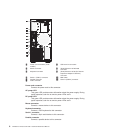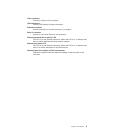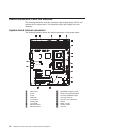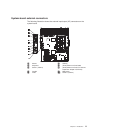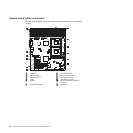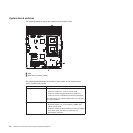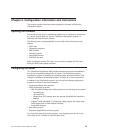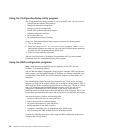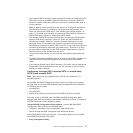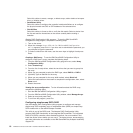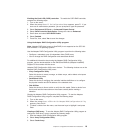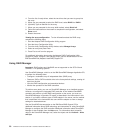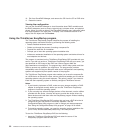Using the Configuration/Setup Utility program
The Configuration/Setup Utility program is part of the BIOS code. You can use it to:
v Change interrupt request (IRQ) settings
v Change the startup drive sequence
v Configure serial-port assignments
v Enable USB keyboard and mouse support
v Resolve configuration conflicts
v Set the date and time
v Set passwords and security settings
To start the Configuration/Setup Utility program, complete the following steps:
1. Turn on the server.
2. When the prompt Press F1 for Configuration/Setup appears, press F1. If an
administrator password has been set, you must type the administrator password
to access the full Configuration/Setup Utility menu.
3. Follow the instructions on the screen.
See the User Guide on the ThinkServer Documentation DVD for more detailed
information about the Configuration/Setup Utility program.
Using the RAID configuration programs
Note: RAID options and HostRAID are not supported on the SCO 6.0 and
UnixWare 7.14 operating systems.
Use the IBM ServeRAID Configuration Utility program, Adaptec RAID Configuration
Utility program, and ServeRAID Manager to configure and manage redundant array
of independent disks (RAID). Be sure to use these programs as described in this
document.
The ServeRAID 8k-l SAS Controller that comes with the TD100 server (hot-swap
SAS and hot-swap SATA models) enables you to configure multiple physical SAS or
SATA hard disk drives to operate as logical drives in a disk array. The server comes
with a CD containing the ServeRAID Manager program, which you can use to
configure the ServeRAID 8k-l SAS Controller. If your server comes with an
operating system installed, such as Microsoft Windows 2000 Datacenter Server, see
the software documentation that comes with the server for configuration information.
Use these programs to perform the following tasks:
v Perform a low-level format on a hard disk drive
v View or change IDs for attached devices
v Set protocol parameters on hard disk drives
v Monitor operation of the RAID controller
v Configure a redundant array of independent disks (RAID) array
v View or change the RAID configuration and associated devices
Consider the following information when using the RAID configuration programs to
configure and manage arrays:
16 ThinkServer TD100 and TD100x: Hardware Maintenance Manual



